Effective Discharge Planning for Hospitalized Patients with Diabetes
VerifiedAdded on 2020/05/16
|12
|2628
|48
Essay
AI Summary
The essay addresses effective strategies in nursing care, concentrating on comprehensive discharge planning and cultural sensitivity to improve patient outcomes. This includes preventing central line-associated infections and managing conditions such as orthostatic hypotension. The assignment underscores the importance of understanding patients' diverse backgrounds and tailoring healthcare practices accordingly, ensuring a smooth transition from hospital to home while maintaining high-quality, culturally competent care.

Running head: NURSING CASE STUDY
Nursing case study
Name of the Student
Name of the University
Author note
Nursing case study
Name of the Student
Name of the University
Author note
Paraphrase This Document
Need a fresh take? Get an instant paraphrase of this document with our AI Paraphraser
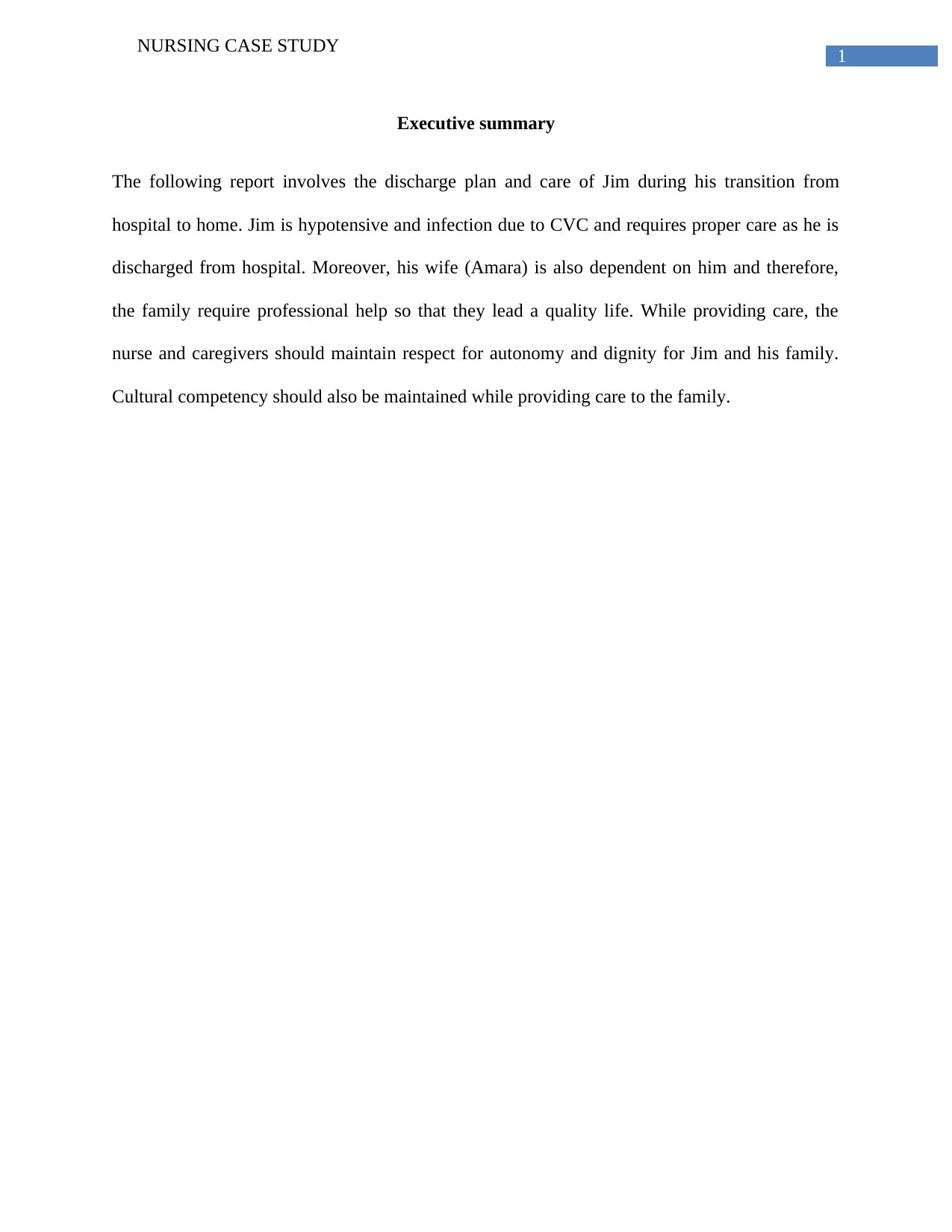
1
NURSING CASE STUDY
Executive summary
The following report involves the discharge plan and care of Jim during his transition from
hospital to home. Jim is hypotensive and infection due to CVC and requires proper care as he is
discharged from hospital. Moreover, his wife (Amara) is also dependent on him and therefore,
the family require professional help so that they lead a quality life. While providing care, the
nurse and caregivers should maintain respect for autonomy and dignity for Jim and his family.
Cultural competency should also be maintained while providing care to the family.
NURSING CASE STUDY
Executive summary
The following report involves the discharge plan and care of Jim during his transition from
hospital to home. Jim is hypotensive and infection due to CVC and requires proper care as he is
discharged from hospital. Moreover, his wife (Amara) is also dependent on him and therefore,
the family require professional help so that they lead a quality life. While providing care, the
nurse and caregivers should maintain respect for autonomy and dignity for Jim and his family.
Cultural competency should also be maintained while providing care to the family.
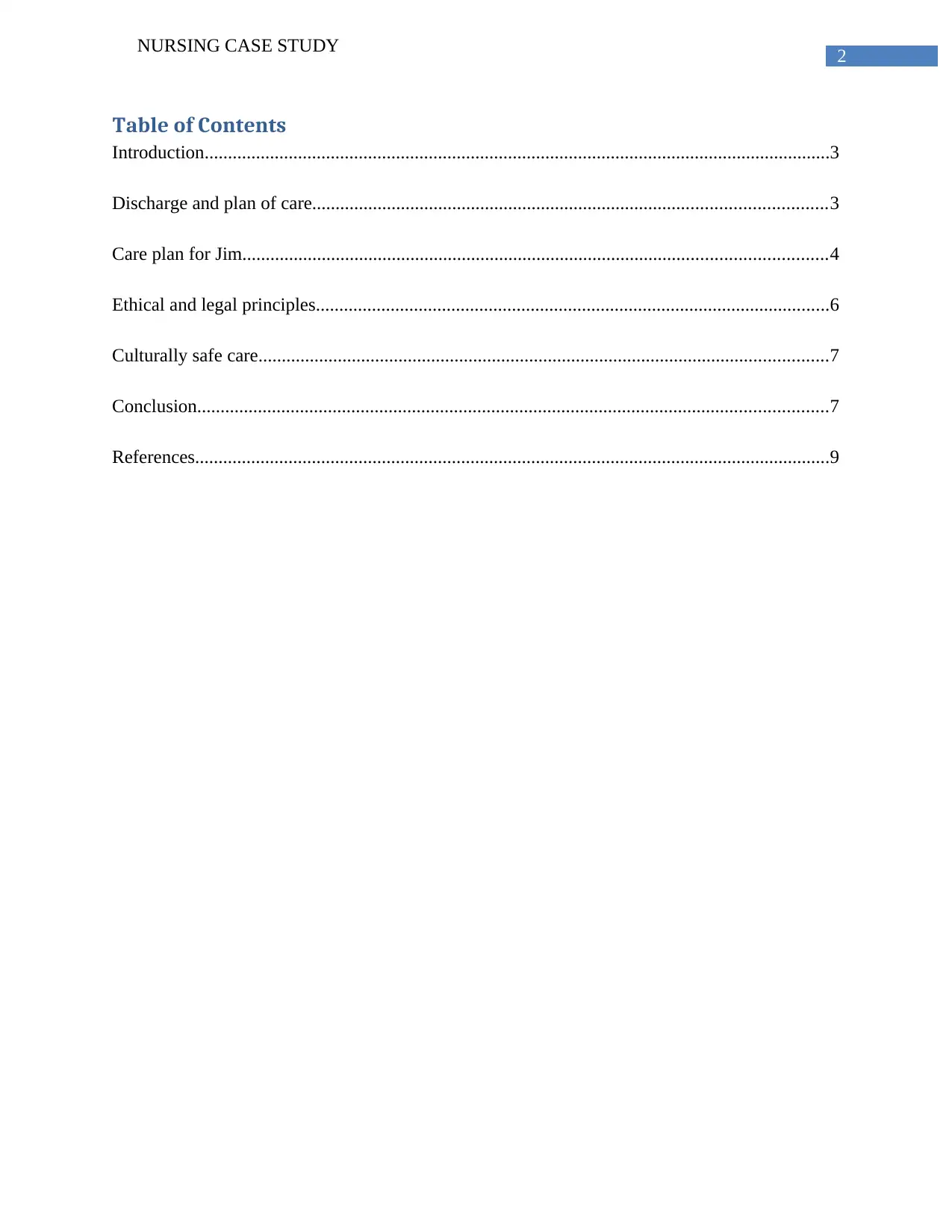
2
NURSING CASE STUDY
Table of Contents
Introduction......................................................................................................................................3
Discharge and plan of care..............................................................................................................3
Care plan for Jim.............................................................................................................................4
Ethical and legal principles..............................................................................................................6
Culturally safe care..........................................................................................................................7
Conclusion.......................................................................................................................................7
References........................................................................................................................................9
NURSING CASE STUDY
Table of Contents
Introduction......................................................................................................................................3
Discharge and plan of care..............................................................................................................3
Care plan for Jim.............................................................................................................................4
Ethical and legal principles..............................................................................................................6
Culturally safe care..........................................................................................................................7
Conclusion.......................................................................................................................................7
References........................................................................................................................................9
⊘ This is a preview!⊘
Do you want full access?
Subscribe today to unlock all pages.

Trusted by 1+ million students worldwide
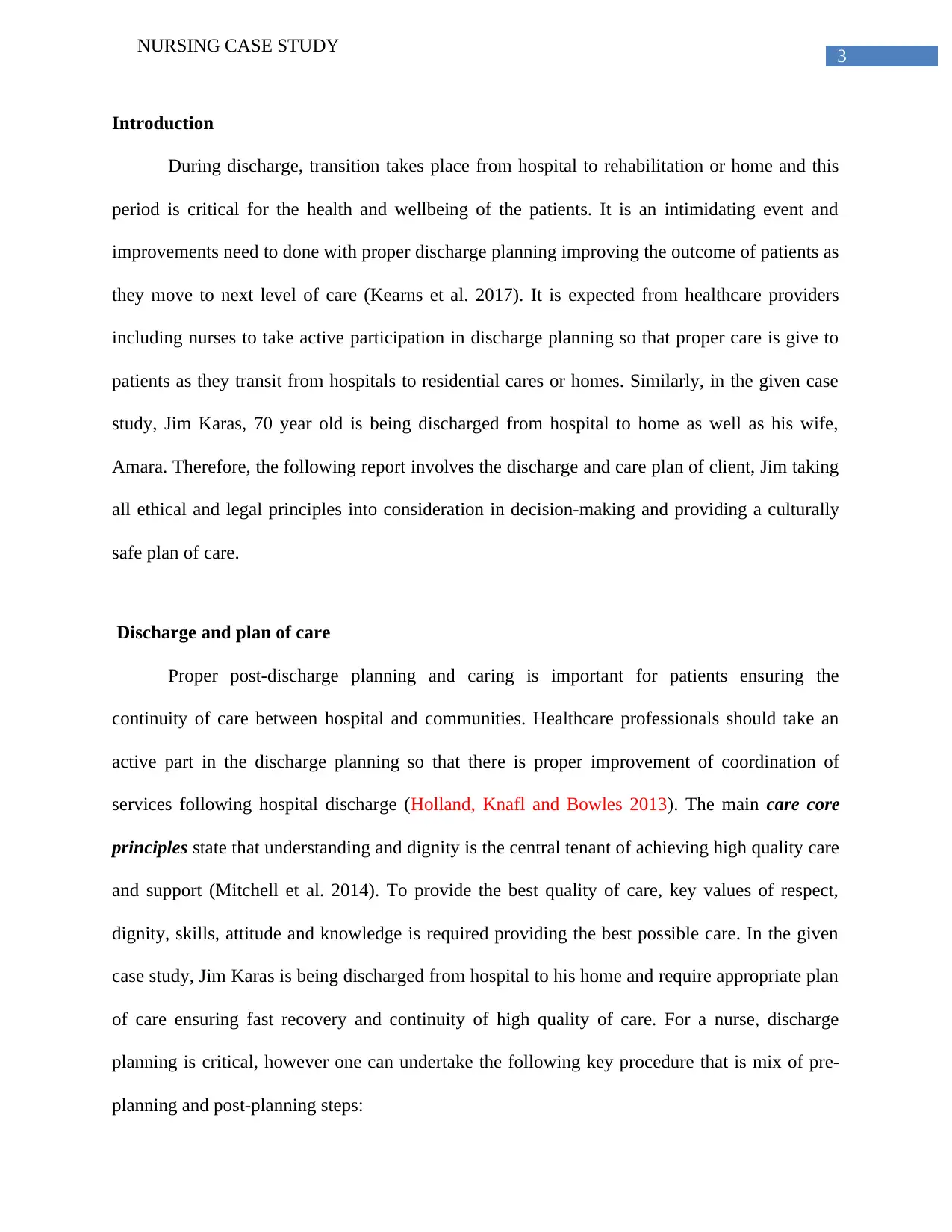
3
NURSING CASE STUDY
Introduction
During discharge, transition takes place from hospital to rehabilitation or home and this
period is critical for the health and wellbeing of the patients. It is an intimidating event and
improvements need to done with proper discharge planning improving the outcome of patients as
they move to next level of care (Kearns et al. 2017). It is expected from healthcare providers
including nurses to take active participation in discharge planning so that proper care is give to
patients as they transit from hospitals to residential cares or homes. Similarly, in the given case
study, Jim Karas, 70 year old is being discharged from hospital to home as well as his wife,
Amara. Therefore, the following report involves the discharge and care plan of client, Jim taking
all ethical and legal principles into consideration in decision-making and providing a culturally
safe plan of care.
Discharge and plan of care
Proper post-discharge planning and caring is important for patients ensuring the
continuity of care between hospital and communities. Healthcare professionals should take an
active part in the discharge planning so that there is proper improvement of coordination of
services following hospital discharge (Holland, Knafl and Bowles 2013). The main care core
principles state that understanding and dignity is the central tenant of achieving high quality care
and support (Mitchell et al. 2014). To provide the best quality of care, key values of respect,
dignity, skills, attitude and knowledge is required providing the best possible care. In the given
case study, Jim Karas is being discharged from hospital to his home and require appropriate plan
of care ensuring fast recovery and continuity of high quality of care. For a nurse, discharge
planning is critical, however one can undertake the following key procedure that is mix of pre-
planning and post-planning steps:
NURSING CASE STUDY
Introduction
During discharge, transition takes place from hospital to rehabilitation or home and this
period is critical for the health and wellbeing of the patients. It is an intimidating event and
improvements need to done with proper discharge planning improving the outcome of patients as
they move to next level of care (Kearns et al. 2017). It is expected from healthcare providers
including nurses to take active participation in discharge planning so that proper care is give to
patients as they transit from hospitals to residential cares or homes. Similarly, in the given case
study, Jim Karas, 70 year old is being discharged from hospital to home as well as his wife,
Amara. Therefore, the following report involves the discharge and care plan of client, Jim taking
all ethical and legal principles into consideration in decision-making and providing a culturally
safe plan of care.
Discharge and plan of care
Proper post-discharge planning and caring is important for patients ensuring the
continuity of care between hospital and communities. Healthcare professionals should take an
active part in the discharge planning so that there is proper improvement of coordination of
services following hospital discharge (Holland, Knafl and Bowles 2013). The main care core
principles state that understanding and dignity is the central tenant of achieving high quality care
and support (Mitchell et al. 2014). To provide the best quality of care, key values of respect,
dignity, skills, attitude and knowledge is required providing the best possible care. In the given
case study, Jim Karas is being discharged from hospital to his home and require appropriate plan
of care ensuring fast recovery and continuity of high quality of care. For a nurse, discharge
planning is critical, however one can undertake the following key procedure that is mix of pre-
planning and post-planning steps:
Paraphrase This Document
Need a fresh take? Get an instant paraphrase of this document with our AI Paraphraser
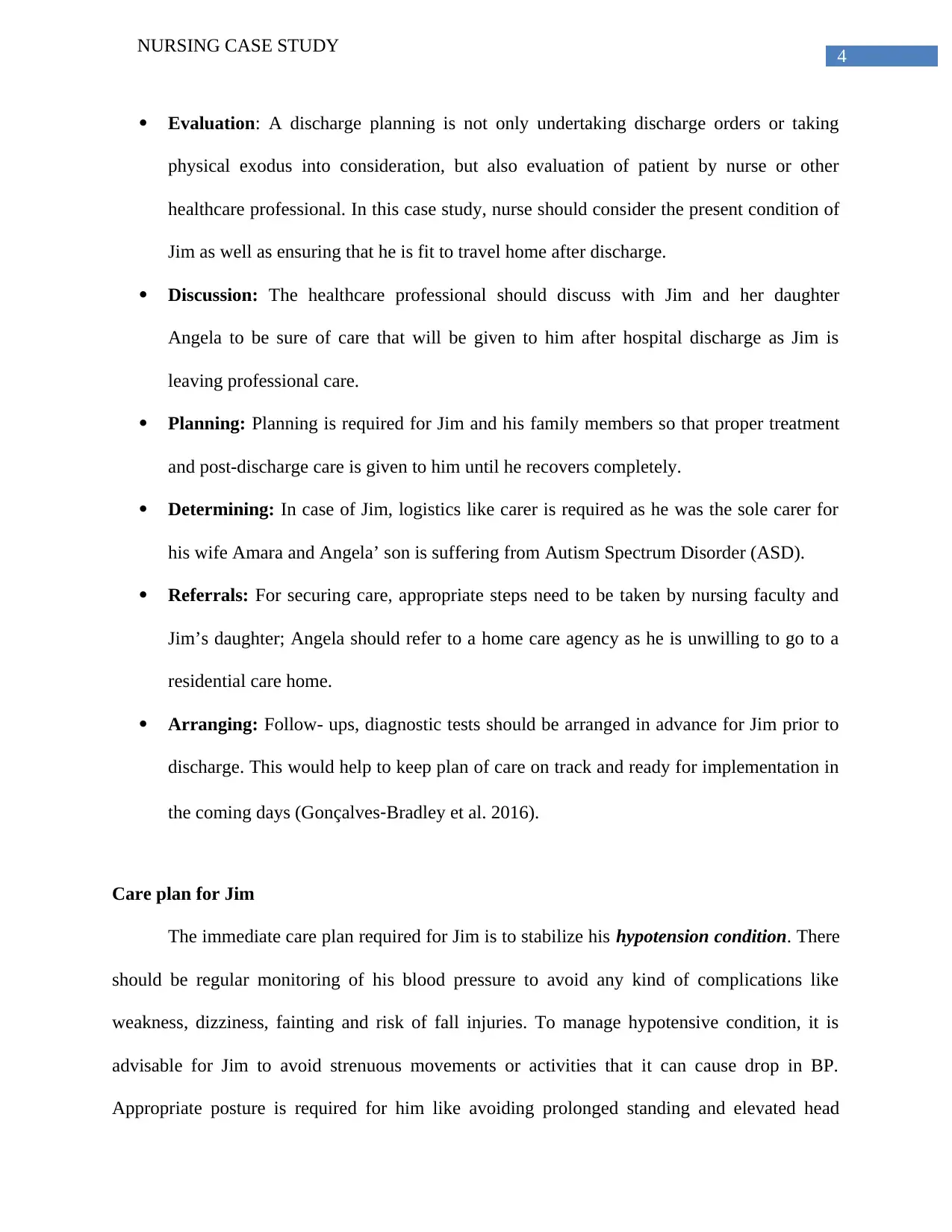
4
NURSING CASE STUDY
Evaluation: A discharge planning is not only undertaking discharge orders or taking
physical exodus into consideration, but also evaluation of patient by nurse or other
healthcare professional. In this case study, nurse should consider the present condition of
Jim as well as ensuring that he is fit to travel home after discharge.
Discussion: The healthcare professional should discuss with Jim and her daughter
Angela to be sure of care that will be given to him after hospital discharge as Jim is
leaving professional care.
Planning: Planning is required for Jim and his family members so that proper treatment
and post-discharge care is given to him until he recovers completely.
Determining: In case of Jim, logistics like carer is required as he was the sole carer for
his wife Amara and Angela’ son is suffering from Autism Spectrum Disorder (ASD).
Referrals: For securing care, appropriate steps need to be taken by nursing faculty and
Jim’s daughter; Angela should refer to a home care agency as he is unwilling to go to a
residential care home.
Arranging: Follow- ups, diagnostic tests should be arranged in advance for Jim prior to
discharge. This would help to keep plan of care on track and ready for implementation in
the coming days (Gonçalves‐Bradley et al. 2016).
Care plan for Jim
The immediate care plan required for Jim is to stabilize his hypotension condition. There
should be regular monitoring of his blood pressure to avoid any kind of complications like
weakness, dizziness, fainting and risk of fall injuries. To manage hypotensive condition, it is
advisable for Jim to avoid strenuous movements or activities that it can cause drop in BP.
Appropriate posture is required for him like avoiding prolonged standing and elevated head
NURSING CASE STUDY
Evaluation: A discharge planning is not only undertaking discharge orders or taking
physical exodus into consideration, but also evaluation of patient by nurse or other
healthcare professional. In this case study, nurse should consider the present condition of
Jim as well as ensuring that he is fit to travel home after discharge.
Discussion: The healthcare professional should discuss with Jim and her daughter
Angela to be sure of care that will be given to him after hospital discharge as Jim is
leaving professional care.
Planning: Planning is required for Jim and his family members so that proper treatment
and post-discharge care is given to him until he recovers completely.
Determining: In case of Jim, logistics like carer is required as he was the sole carer for
his wife Amara and Angela’ son is suffering from Autism Spectrum Disorder (ASD).
Referrals: For securing care, appropriate steps need to be taken by nursing faculty and
Jim’s daughter; Angela should refer to a home care agency as he is unwilling to go to a
residential care home.
Arranging: Follow- ups, diagnostic tests should be arranged in advance for Jim prior to
discharge. This would help to keep plan of care on track and ready for implementation in
the coming days (Gonçalves‐Bradley et al. 2016).
Care plan for Jim
The immediate care plan required for Jim is to stabilize his hypotension condition. There
should be regular monitoring of his blood pressure to avoid any kind of complications like
weakness, dizziness, fainting and risk of fall injuries. To manage hypotensive condition, it is
advisable for Jim to avoid strenuous movements or activities that it can cause drop in BP.
Appropriate posture is required for him like avoiding prolonged standing and elevated head
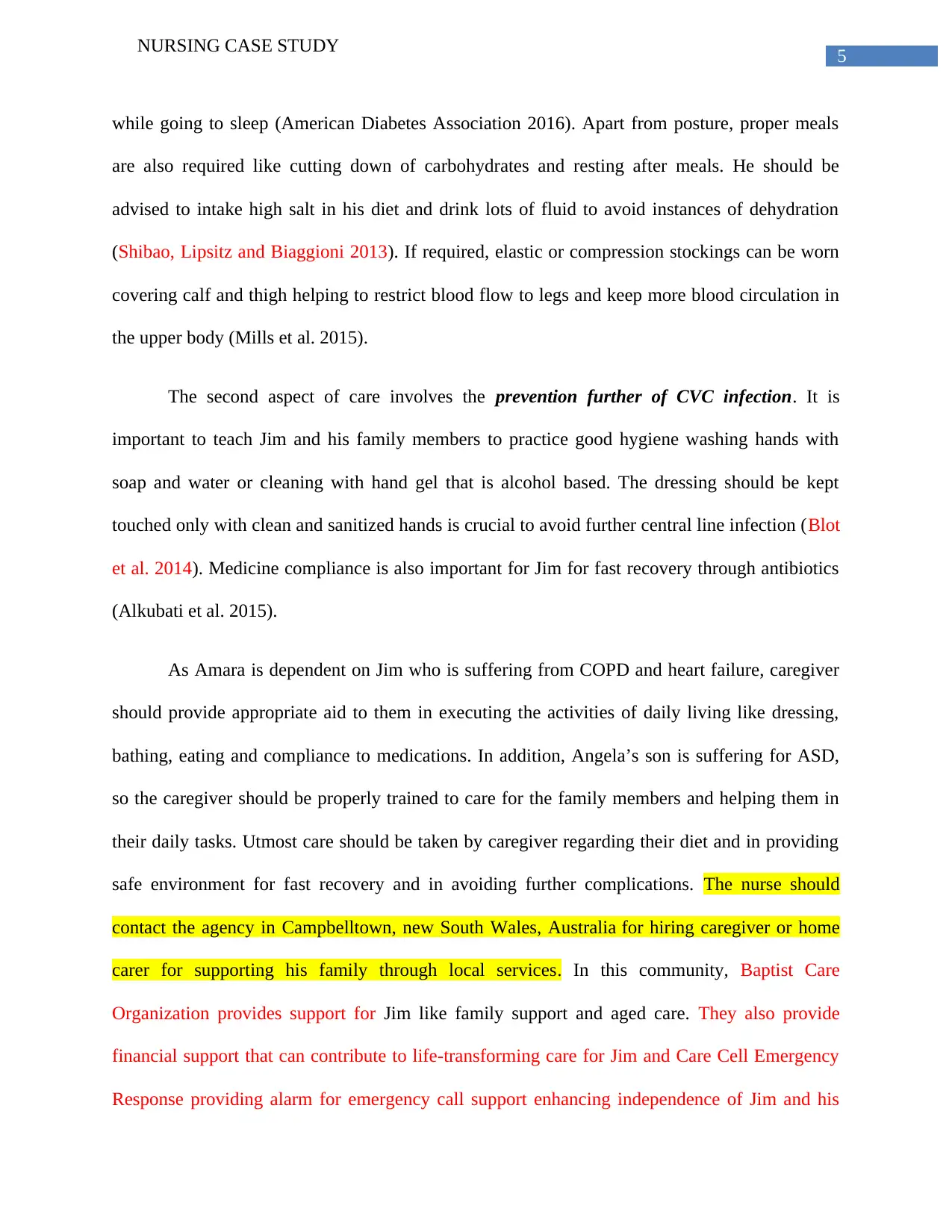
5
NURSING CASE STUDY
while going to sleep (American Diabetes Association 2016). Apart from posture, proper meals
are also required like cutting down of carbohydrates and resting after meals. He should be
advised to intake high salt in his diet and drink lots of fluid to avoid instances of dehydration
(Shibao, Lipsitz and Biaggioni 2013). If required, elastic or compression stockings can be worn
covering calf and thigh helping to restrict blood flow to legs and keep more blood circulation in
the upper body (Mills et al. 2015).
The second aspect of care involves the prevention further of CVC infection. It is
important to teach Jim and his family members to practice good hygiene washing hands with
soap and water or cleaning with hand gel that is alcohol based. The dressing should be kept
touched only with clean and sanitized hands is crucial to avoid further central line infection (Blot
et al. 2014). Medicine compliance is also important for Jim for fast recovery through antibiotics
(Alkubati et al. 2015).
As Amara is dependent on Jim who is suffering from COPD and heart failure, caregiver
should provide appropriate aid to them in executing the activities of daily living like dressing,
bathing, eating and compliance to medications. In addition, Angela’s son is suffering for ASD,
so the caregiver should be properly trained to care for the family members and helping them in
their daily tasks. Utmost care should be taken by caregiver regarding their diet and in providing
safe environment for fast recovery and in avoiding further complications. The nurse should
contact the agency in Campbelltown, new South Wales, Australia for hiring caregiver or home
carer for supporting his family through local services. In this community, Baptist Care
Organization provides support for Jim like family support and aged care. They also provide
financial support that can contribute to life-transforming care for Jim and Care Cell Emergency
Response providing alarm for emergency call support enhancing independence of Jim and his
NURSING CASE STUDY
while going to sleep (American Diabetes Association 2016). Apart from posture, proper meals
are also required like cutting down of carbohydrates and resting after meals. He should be
advised to intake high salt in his diet and drink lots of fluid to avoid instances of dehydration
(Shibao, Lipsitz and Biaggioni 2013). If required, elastic or compression stockings can be worn
covering calf and thigh helping to restrict blood flow to legs and keep more blood circulation in
the upper body (Mills et al. 2015).
The second aspect of care involves the prevention further of CVC infection. It is
important to teach Jim and his family members to practice good hygiene washing hands with
soap and water or cleaning with hand gel that is alcohol based. The dressing should be kept
touched only with clean and sanitized hands is crucial to avoid further central line infection (Blot
et al. 2014). Medicine compliance is also important for Jim for fast recovery through antibiotics
(Alkubati et al. 2015).
As Amara is dependent on Jim who is suffering from COPD and heart failure, caregiver
should provide appropriate aid to them in executing the activities of daily living like dressing,
bathing, eating and compliance to medications. In addition, Angela’s son is suffering for ASD,
so the caregiver should be properly trained to care for the family members and helping them in
their daily tasks. Utmost care should be taken by caregiver regarding their diet and in providing
safe environment for fast recovery and in avoiding further complications. The nurse should
contact the agency in Campbelltown, new South Wales, Australia for hiring caregiver or home
carer for supporting his family through local services. In this community, Baptist Care
Organization provides support for Jim like family support and aged care. They also provide
financial support that can contribute to life-transforming care for Jim and Care Cell Emergency
Response providing alarm for emergency call support enhancing independence of Jim and his
⊘ This is a preview!⊘
Do you want full access?
Subscribe today to unlock all pages.

Trusted by 1+ million students worldwide

6
NURSING CASE STUDY
family. This organization offers services in Greek language supporting his family. This
organization also offers training to carers for learning skills in caring and gain access to
resources and services that can help them to provide better care to Jim and his family.
Effective transition from acute care to community care is an important part of high
quality care of patients and is one of the core duties of the hospitals. This activity is more
effective when the hospital nurses, community providers and primary care physicians act
together and communicate effectively to provide the required care interventions for the patients
and the family members. The acute care nurses should not only provide references to Jim about
local care but should themselves communicate with the local care providers and engage in
discussion sessions. This would ensure that all the healthcare requirements that Jim and Amara
need are met properly. Not only that, both should curve out detailed planning and engage in
decision making about the approaches that both the patients would need at home ensuring that
proper resources are provided to them on time. They should maintain the autonomy and dignity
of both of them and engage them in all decision making. The acute care nurse should also aware
the community nurse about their cultural backgrounds and help the local service in meeting the
preferences of Amara specifically as she is not comfortable with English.
Ethical and legal principles
The ethical principle of autonomy suggests that patients should be allowed to make their
own decision and take an active part in decision-making process. In the given case study, Jim
wants to remain in his own home and strongly objects the option of residential care for him. In
addition, he believes that he can take better care of Amara and they decided to stay in their own
NURSING CASE STUDY
family. This organization offers services in Greek language supporting his family. This
organization also offers training to carers for learning skills in caring and gain access to
resources and services that can help them to provide better care to Jim and his family.
Effective transition from acute care to community care is an important part of high
quality care of patients and is one of the core duties of the hospitals. This activity is more
effective when the hospital nurses, community providers and primary care physicians act
together and communicate effectively to provide the required care interventions for the patients
and the family members. The acute care nurses should not only provide references to Jim about
local care but should themselves communicate with the local care providers and engage in
discussion sessions. This would ensure that all the healthcare requirements that Jim and Amara
need are met properly. Not only that, both should curve out detailed planning and engage in
decision making about the approaches that both the patients would need at home ensuring that
proper resources are provided to them on time. They should maintain the autonomy and dignity
of both of them and engage them in all decision making. The acute care nurse should also aware
the community nurse about their cultural backgrounds and help the local service in meeting the
preferences of Amara specifically as she is not comfortable with English.
Ethical and legal principles
The ethical principle of autonomy suggests that patients should be allowed to make their
own decision and take an active part in decision-making process. In the given case study, Jim
wants to remain in his own home and strongly objects the option of residential care for him. In
addition, he believes that he can take better care of Amara and they decided to stay in their own
Paraphrase This Document
Need a fresh take? Get an instant paraphrase of this document with our AI Paraphraser

7
NURSING CASE STUDY
house instead of any residential home care or a small house or unit. In such instances, the nurse
cannot go against his decision and force him to seek professional assistance. The nurse has to
respect his decision complying with principle of respect for autonomy and dignity. Moreover,
while respecting Jim’s decision, the nurse need to comply with principle of beneficence and
non-maleficence. This can be explained in a way where the nurse should work towards
promoting good health for the family members and fast recovery. The care plan should be
focused on providing a safe environment for the family directed towards benefit and fast
recovery (Pope, Hough and Chase 2016). Through effective communication skills (interpersonal
skills), the nurse should explain Jim and his family members for seeking professional support as
apart from Angela, other family members including Thomas who is suffering from ASD
(Kourkouta and Papathanasiou 2014). The nurse should advocate strength-based approaches
concentrating on strengths of Jim and his family members aiding empowerment and recovery. A
qualified home carer should be appointed by the nurse from the local community who can
support the family members’ needs and preferences (Jones 2017). This approach in nursing is
based on the fact that all individuals have their own strengths and while focusing on their
interests and skills through empowerment. Through this, Jim and his family members would be
able to overcome their emotional, physical and emotional trauma that they are facing in turn
improving individual outcomes like health and quality of life. Strength-based nursing
leadership can be helpful where Jim and his family members should be encouraged to take in
charge of their health and responsible for healing and recovery. Through collaborative
relationship between nurse and family members, the overall goal of health and wellbeing can be
achieved (MacKie 2016).
NURSING CASE STUDY
house instead of any residential home care or a small house or unit. In such instances, the nurse
cannot go against his decision and force him to seek professional assistance. The nurse has to
respect his decision complying with principle of respect for autonomy and dignity. Moreover,
while respecting Jim’s decision, the nurse need to comply with principle of beneficence and
non-maleficence. This can be explained in a way where the nurse should work towards
promoting good health for the family members and fast recovery. The care plan should be
focused on providing a safe environment for the family directed towards benefit and fast
recovery (Pope, Hough and Chase 2016). Through effective communication skills (interpersonal
skills), the nurse should explain Jim and his family members for seeking professional support as
apart from Angela, other family members including Thomas who is suffering from ASD
(Kourkouta and Papathanasiou 2014). The nurse should advocate strength-based approaches
concentrating on strengths of Jim and his family members aiding empowerment and recovery. A
qualified home carer should be appointed by the nurse from the local community who can
support the family members’ needs and preferences (Jones 2017). This approach in nursing is
based on the fact that all individuals have their own strengths and while focusing on their
interests and skills through empowerment. Through this, Jim and his family members would be
able to overcome their emotional, physical and emotional trauma that they are facing in turn
improving individual outcomes like health and quality of life. Strength-based nursing
leadership can be helpful where Jim and his family members should be encouraged to take in
charge of their health and responsible for healing and recovery. Through collaborative
relationship between nurse and family members, the overall goal of health and wellbeing can be
achieved (MacKie 2016).
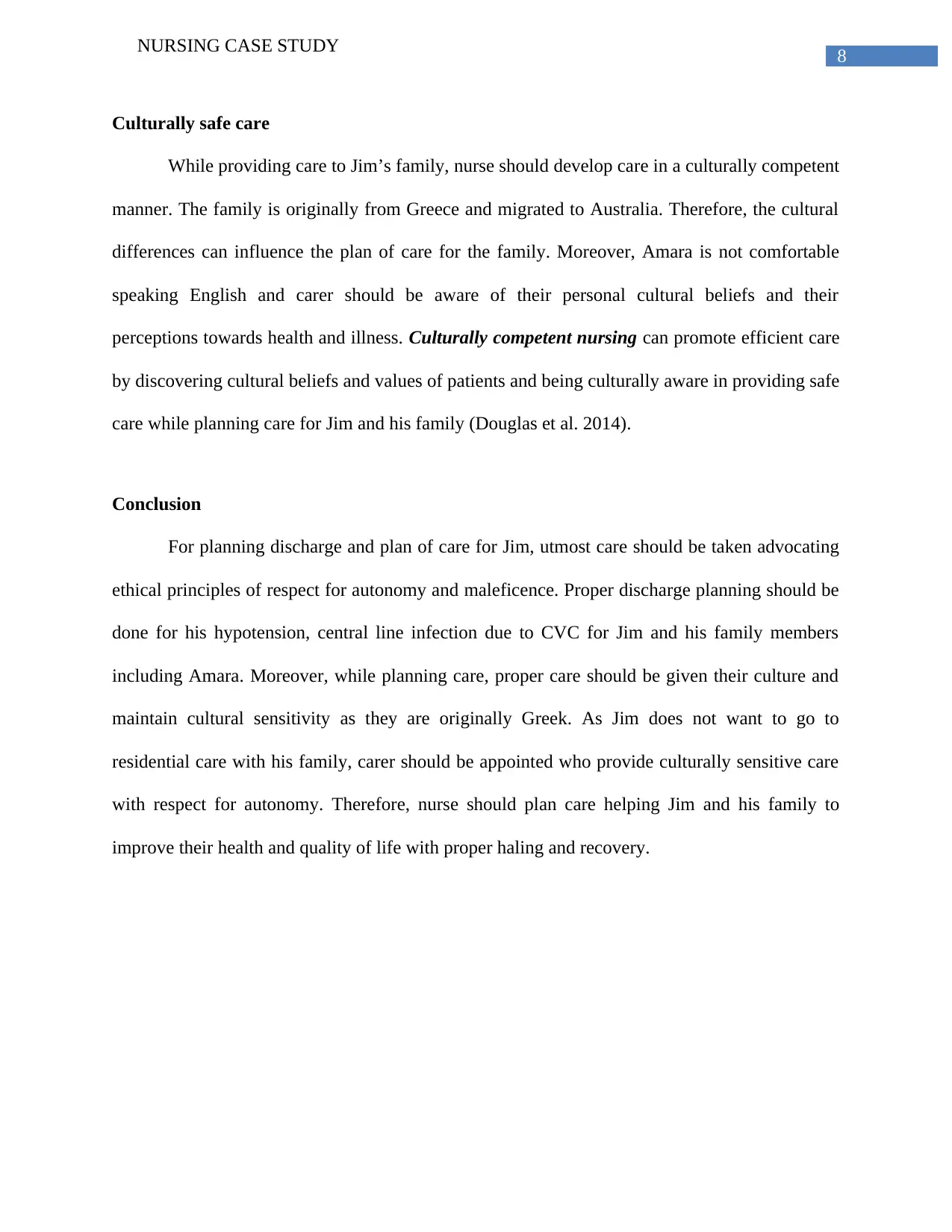
8
NURSING CASE STUDY
Culturally safe care
While providing care to Jim’s family, nurse should develop care in a culturally competent
manner. The family is originally from Greece and migrated to Australia. Therefore, the cultural
differences can influence the plan of care for the family. Moreover, Amara is not comfortable
speaking English and carer should be aware of their personal cultural beliefs and their
perceptions towards health and illness. Culturally competent nursing can promote efficient care
by discovering cultural beliefs and values of patients and being culturally aware in providing safe
care while planning care for Jim and his family (Douglas et al. 2014).
Conclusion
For planning discharge and plan of care for Jim, utmost care should be taken advocating
ethical principles of respect for autonomy and maleficence. Proper discharge planning should be
done for his hypotension, central line infection due to CVC for Jim and his family members
including Amara. Moreover, while planning care, proper care should be given their culture and
maintain cultural sensitivity as they are originally Greek. As Jim does not want to go to
residential care with his family, carer should be appointed who provide culturally sensitive care
with respect for autonomy. Therefore, nurse should plan care helping Jim and his family to
improve their health and quality of life with proper haling and recovery.
NURSING CASE STUDY
Culturally safe care
While providing care to Jim’s family, nurse should develop care in a culturally competent
manner. The family is originally from Greece and migrated to Australia. Therefore, the cultural
differences can influence the plan of care for the family. Moreover, Amara is not comfortable
speaking English and carer should be aware of their personal cultural beliefs and their
perceptions towards health and illness. Culturally competent nursing can promote efficient care
by discovering cultural beliefs and values of patients and being culturally aware in providing safe
care while planning care for Jim and his family (Douglas et al. 2014).
Conclusion
For planning discharge and plan of care for Jim, utmost care should be taken advocating
ethical principles of respect for autonomy and maleficence. Proper discharge planning should be
done for his hypotension, central line infection due to CVC for Jim and his family members
including Amara. Moreover, while planning care, proper care should be given their culture and
maintain cultural sensitivity as they are originally Greek. As Jim does not want to go to
residential care with his family, carer should be appointed who provide culturally sensitive care
with respect for autonomy. Therefore, nurse should plan care helping Jim and his family to
improve their health and quality of life with proper haling and recovery.
⊘ This is a preview!⊘
Do you want full access?
Subscribe today to unlock all pages.

Trusted by 1+ million students worldwide
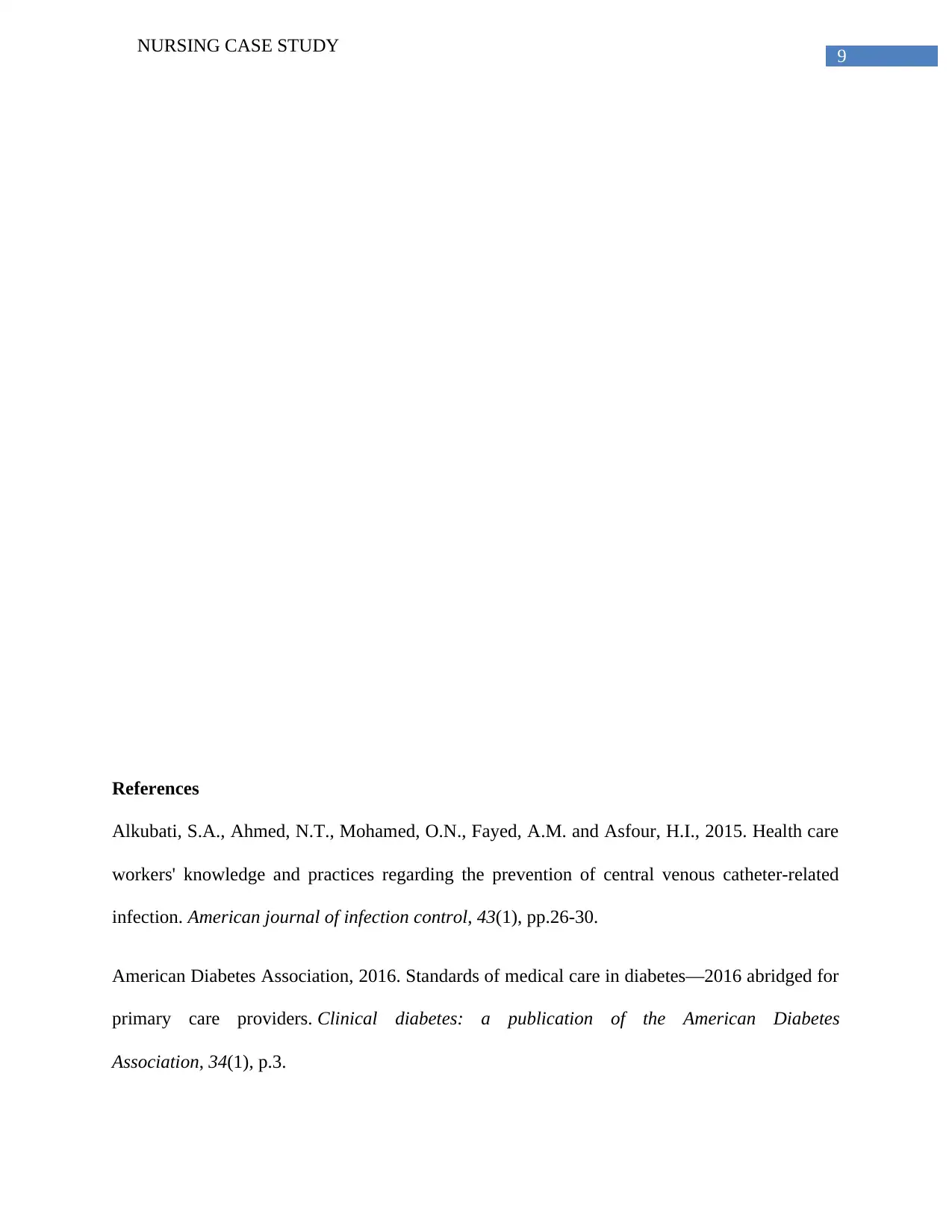
9
NURSING CASE STUDY
References
Alkubati, S.A., Ahmed, N.T., Mohamed, O.N., Fayed, A.M. and Asfour, H.I., 2015. Health care
workers' knowledge and practices regarding the prevention of central venous catheter-related
infection. American journal of infection control, 43(1), pp.26-30.
American Diabetes Association, 2016. Standards of medical care in diabetes—2016 abridged for
primary care providers. Clinical diabetes: a publication of the American Diabetes
Association, 34(1), p.3.
NURSING CASE STUDY
References
Alkubati, S.A., Ahmed, N.T., Mohamed, O.N., Fayed, A.M. and Asfour, H.I., 2015. Health care
workers' knowledge and practices regarding the prevention of central venous catheter-related
infection. American journal of infection control, 43(1), pp.26-30.
American Diabetes Association, 2016. Standards of medical care in diabetes—2016 abridged for
primary care providers. Clinical diabetes: a publication of the American Diabetes
Association, 34(1), p.3.
Paraphrase This Document
Need a fresh take? Get an instant paraphrase of this document with our AI Paraphraser

10
NURSING CASE STUDY
Blot, K., Bergs, J., Vogelaers, D., Blot, S. and Vandijck, D., 2014. Prevention of Central Line–
Associated Bloodstream Infections Through Quality Improvement Interventions: A Systematic
Review and Meta-analysis. Clinical Infectious Diseases, 59(1), pp.96-105.
Douglas, M.K., Rosenkoetter, M., Pacquiao, D.F., Callister, L.C., Hattar-Pollara, M.,
Lauderdale, J., Milstead, J., Nardi, D. and Purnell, L., 2014. Guidelines for implementing
culturally competent nursing care. Journal of Transcultural Nursing, 25(2), pp.109-121.
Gonçalves‐Bradley, D.C., Lannin, N.A., Clemson, L.M., Cameron, I.D. and Shepperd, S., 2016.
Discharge planning from hospital. The Cochrane Library.
Holland, D.E., Knafl, G.J. and Bowles, K.H., 2013. Targeting hospitalised patients for early
discharge planning intervention. Journal of clinical nursing, 22(19-20), pp.2696-2703.
Jones, A.K., 2017. Oncology Nurse Retreat: A Strength-based Approach to Self-care and
Personal Resilience. Clinical journal of oncology nursing, 21(2), pp.259-262.
Kearns, M., Curran, M., Collier, D., Burke, M. and Lawler, M., 2017. The Community
Intervention Team as a means of improving the transition from hospital to home for
patients. International Journal of Integrated Care, 17(5).
Kourkouta, L. and Papathanasiou, I.V., 2014. Communication in nursing practice. Materia socio-
medica, 26(1), p.65.
MacKie, D., 2016. Strength-based Leadership Coaching in Organizations: An Evidence-based
Guide to Positive Leadership Development. Kogan Page Publishers.
NURSING CASE STUDY
Blot, K., Bergs, J., Vogelaers, D., Blot, S. and Vandijck, D., 2014. Prevention of Central Line–
Associated Bloodstream Infections Through Quality Improvement Interventions: A Systematic
Review and Meta-analysis. Clinical Infectious Diseases, 59(1), pp.96-105.
Douglas, M.K., Rosenkoetter, M., Pacquiao, D.F., Callister, L.C., Hattar-Pollara, M.,
Lauderdale, J., Milstead, J., Nardi, D. and Purnell, L., 2014. Guidelines for implementing
culturally competent nursing care. Journal of Transcultural Nursing, 25(2), pp.109-121.
Gonçalves‐Bradley, D.C., Lannin, N.A., Clemson, L.M., Cameron, I.D. and Shepperd, S., 2016.
Discharge planning from hospital. The Cochrane Library.
Holland, D.E., Knafl, G.J. and Bowles, K.H., 2013. Targeting hospitalised patients for early
discharge planning intervention. Journal of clinical nursing, 22(19-20), pp.2696-2703.
Jones, A.K., 2017. Oncology Nurse Retreat: A Strength-based Approach to Self-care and
Personal Resilience. Clinical journal of oncology nursing, 21(2), pp.259-262.
Kearns, M., Curran, M., Collier, D., Burke, M. and Lawler, M., 2017. The Community
Intervention Team as a means of improving the transition from hospital to home for
patients. International Journal of Integrated Care, 17(5).
Kourkouta, L. and Papathanasiou, I.V., 2014. Communication in nursing practice. Materia socio-
medica, 26(1), p.65.
MacKie, D., 2016. Strength-based Leadership Coaching in Organizations: An Evidence-based
Guide to Positive Leadership Development. Kogan Page Publishers.
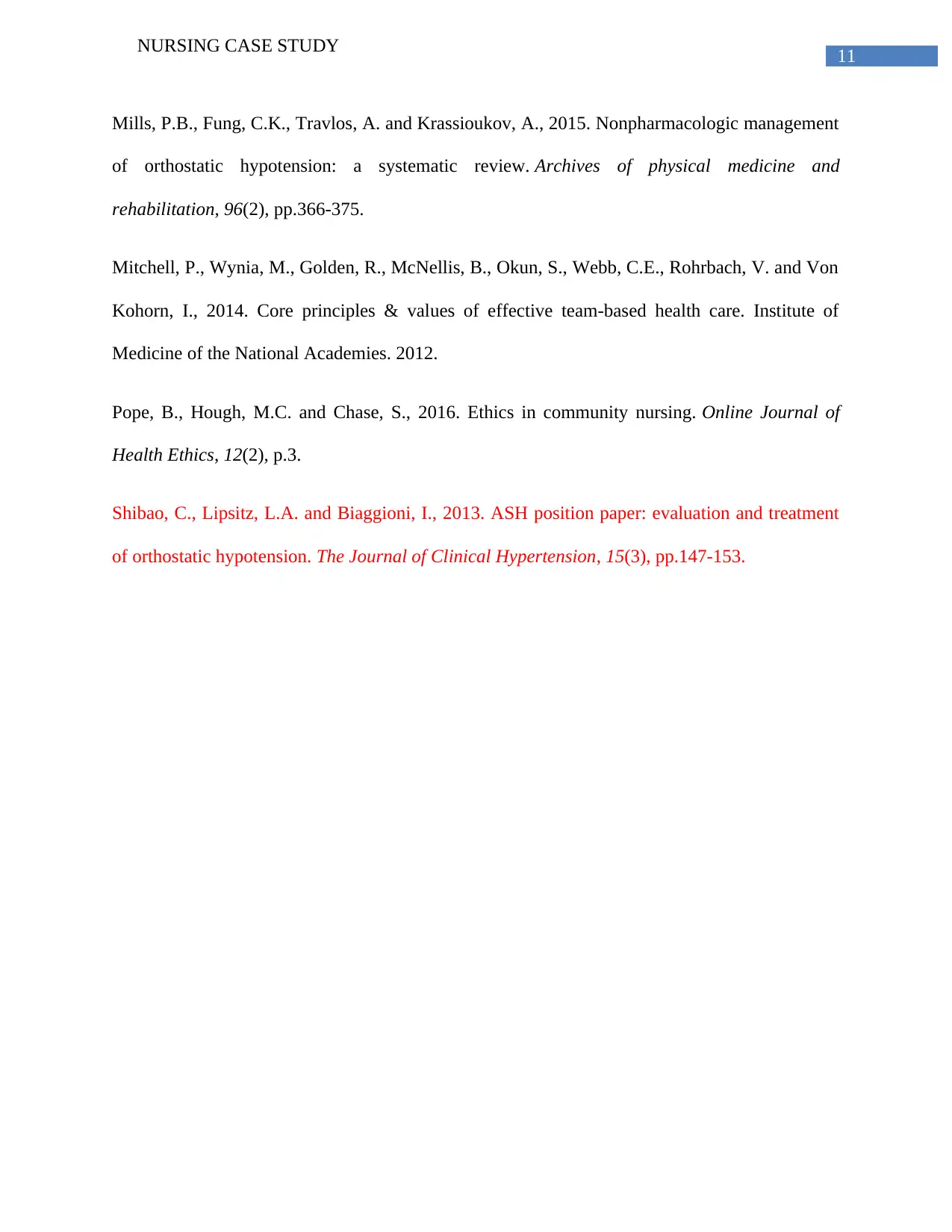
11
NURSING CASE STUDY
Mills, P.B., Fung, C.K., Travlos, A. and Krassioukov, A., 2015. Nonpharmacologic management
of orthostatic hypotension: a systematic review. Archives of physical medicine and
rehabilitation, 96(2), pp.366-375.
Mitchell, P., Wynia, M., Golden, R., McNellis, B., Okun, S., Webb, C.E., Rohrbach, V. and Von
Kohorn, I., 2014. Core principles & values of effective team-based health care. Institute of
Medicine of the National Academies. 2012.
Pope, B., Hough, M.C. and Chase, S., 2016. Ethics in community nursing. Online Journal of
Health Ethics, 12(2), p.3.
Shibao, C., Lipsitz, L.A. and Biaggioni, I., 2013. ASH position paper: evaluation and treatment
of orthostatic hypotension. The Journal of Clinical Hypertension, 15(3), pp.147-153.
NURSING CASE STUDY
Mills, P.B., Fung, C.K., Travlos, A. and Krassioukov, A., 2015. Nonpharmacologic management
of orthostatic hypotension: a systematic review. Archives of physical medicine and
rehabilitation, 96(2), pp.366-375.
Mitchell, P., Wynia, M., Golden, R., McNellis, B., Okun, S., Webb, C.E., Rohrbach, V. and Von
Kohorn, I., 2014. Core principles & values of effective team-based health care. Institute of
Medicine of the National Academies. 2012.
Pope, B., Hough, M.C. and Chase, S., 2016. Ethics in community nursing. Online Journal of
Health Ethics, 12(2), p.3.
Shibao, C., Lipsitz, L.A. and Biaggioni, I., 2013. ASH position paper: evaluation and treatment
of orthostatic hypotension. The Journal of Clinical Hypertension, 15(3), pp.147-153.
⊘ This is a preview!⊘
Do you want full access?
Subscribe today to unlock all pages.

Trusted by 1+ million students worldwide
1 out of 12
Related Documents
Your All-in-One AI-Powered Toolkit for Academic Success.
+13062052269
info@desklib.com
Available 24*7 on WhatsApp / Email
![[object Object]](/_next/static/media/star-bottom.7253800d.svg)
Unlock your academic potential
Copyright © 2020–2025 A2Z Services. All Rights Reserved. Developed and managed by ZUCOL.





